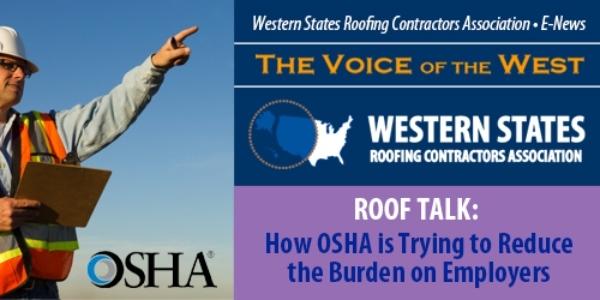How OSHA is Trying to Reduce the Burden on Employers

By Cotney Construction Law for WSRCA.
The Occupational Safety and Health Administration (OSHA) is instituting a handful of new rules that took effect on July 15, 2019.
The overarching goal of these updates is to streamline processes, decrease paperwork, and preserve funds. The final rule will lead to fourteen standards revisions related to record keeping, construction, and more. OSHA believes that companies in the United States will save up to $6.1 million annually as a result. In this article, we will discuss these upcoming changes and explain how they will reduce the burden on employers.
Compliance Made Easy
It might feel like OSHA is constantly lurking in the shadows, waiting to lash out against employers who fail to maintain absolute compliance, but their real motivations are much less sinister. OSHA wants all contractors to facilitate a safe project site. The citations and penalties incurred along the way are meant to improve safety. While OSHA is concerned with maintaining workplace safety nationwide, they’re also looking for ways to streamline compliance and lessen the burden on contractors.
Changes Pending
This notion is best illustrated by OSHA’s recent move to scrap some proposed changes to its current lockout/tagout standards. Since the proposed changes had a high chance of increasing the burden on employers, the agency decided to hold off. Instead of reinventing the wheel and throwing employers into a frenzy, OSHA has decided to implement a series of distinct rules regarding lockout/tagout. OSHA is even encouraging employers to speak out to let them know if proposed rules are going to do more harm than good. OSHA must take a balanced approach. When new rules are too stringent, it throws off our industries and creates other problems. When new rules are too lax, it leads to more injuries and potential fatalities.
Overview
Not all of OSHA's rule changes apply to the construction industry. For example, redacting feral cats from the definition of vermin isn’t going to have any serious repercussions for contractors. However, contractors should be aware of the following:
- Employers must now post latitude and longitude data (or other location-identification information) on project sites with poor cell service.
- The minimum breaking strength for lifelines has been reduced from 5,400 pounds to 5,000 pounds.
- To preserve privacy, employers are no longer required to include their workers’ Social Security numbers on certain forms.
Legal Disclaimer
All rights reserved. All content (text, trademarks, illustrations, reports, photos, logos, graphics, files, designs, arrangements, etc.) in this Technical Opinion (“Opinion”) is the intellectual property of Western States Roofing Contractors Association (WSRCA) and is protected by the applicable protective laws governing intellectual property. The Opinion is intended for the exclusive use by its members as a feature of their membership. This document is intended to be used for educational purposes only, and no one should act or rely solely on any information contained in this Opinion as it is not a substitute for the advice of an attorney or construction engineer with specific project knowledge. Neither WSRCA nor any of its, contractors, subcontractors, or any of their employees, directors, officers, agents, or assigns make any warranty, express or implied, or assumes any legal liability or responsibility for the accuracy, completeness, or any third party’s use (or the results of such use) of any information or process disclosed in the Opinion. Reference herein to any general or specific commercial product, process or service does not necessarily constitute or imply its endorsement or recommendation by WSRCA. References are provided as citations and aids to help identify and locate other resources that may be of interest, and are not intended to state or imply that WSRCA sponsors, is affiliated or associated with, or is legally responsible for the content reflected in those resources. WSRCA has no control over those resources and the inclusion of any references does not necessarily imply the recommendation or endorsement of same
Not a member of the Western States Roofing Contractors Association? Learn about the benefits of membership.
Original article source: WSRCA






















Comments
Leave a Reply
Have an account? Login to leave a comment!
Sign In